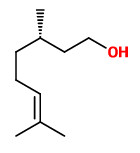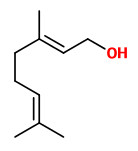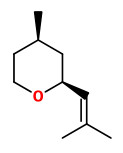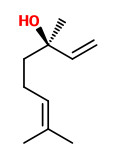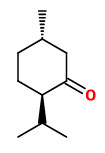Pelargonium graveolens L’Hér. - Geraniaceae - rose geranium, rose-scented geranium, Rosengeranie
„The true Pelargonium graveolens is an uncommon species in the Pelargonium genus, which is native to South Africa, Zimbabwe and Mozambique, while the plants cultivated under this name (spelled P. 'Graveolens') differ from the wild specimens and are of hybrid origin (a probable cross between Pelargonium graveolens, P. capitatum and / or P. radens, or other closely related species). Often called a geranium, as it falls within the plant family Geraniaceae, and was previously categorised under the same genus. The common P. 'Graveolens' or P. 'Rosat' has great importance in the perfume industry… Commercial vendors often list the source of geranium or rose geranium essential oil as Pelargonium graveolens regardless of its botanical name.“
http://en.wikipedia.org/wiki/Pelargonium_graveolens
„The chemical constituents of the essential oil Pelargonium graveolens leaves were analyzed by GC and GC-MS. Thirty compounds accounting for 99.1% of the oil were identified. The main components identified were citronellol (33.6%), geraniol (26.8%), linalool (10.5%), citronellyl formate (9.7%) and p-menthone (6.0%).“
[Chemical constituents of essential oil of Pelargonium graveolens leaves. Virendra S. Rana, Jitendra P. Juyal, M. Amparo Blazquez, International Journal of Aromatherapy, Vol.12 (4), 2002, 216-218]
„The three cultivars of geranium, Algerian, Bourbon and Egyptian, which are presently being cultivated in India, are hybrids originating from Pelargonium graveolens, P. radens and P. capitatum….
The minimum and maximum essential oil yields (% v/w) in a Clevenger apparatus produced by the water distillation method were 0.18% and 0.22%, respectively… The major constituents, viz. citronellol, geraniol, linalool, isomenthone, citronellyl formate, geranyl formate and 10-epi-γ-eudesmol, and minor constituents, viz. cis- and trans-rose oxides, α-terpineol, geranyl acetate, citronellyl butyrate, geranyl butyrate, guaia-6,9-diene, germacrene D, 2-phenylethyl tiglate and geranyl tiglate, etc., are present in all the samples.
Geranium oil produced in a Clevenger-type apparatus by the water distillation method was found to be rich
in geraniol (22.12%) and citronellyl tiglate (0.84%). The oil produced on a pilot scale by the water distillation method contained higher percentages of cis-3-hexenol (0.37%), nerol (0.82%). Samples produced by the water-steam distillation method were rich in α-pinene (0.33%), sabinene (0.20%), myrcene (0.22%), cis-rose oxide (0.44%) and geranial (0.52%)… ‘Direct oil’ produced by the steam distillation method with cohobation and without recycling of hydrosol contained higher percentages of limonene (0.28%), trans-rose oxide (0.28%), citronellyl butyrate (1.19%), geranyl butyrate (0.29%), β-bourbonene (1.32%), β-caryophyllene (1.06%), α-humulene (0.31%), geranyl-n-propionate (0.5%). α-Phellandrene, cis-3-hexenol, p-cymene, trans-linalool oxide, cis-rose oxide and neryl formate were found in traces.“
[Variation in essential oil composition of rose-scented geranium (Pelargonium sp.) distilled by different distillation techniques. Kiran G. D. Babu and V. K. Kaul, Flavour Fragr. J. 2005; 20: 222–231]
„Commercial geranium oil consists in ca. 80% of equal parts of (-)-(S)-citronellol and geraniol, along with small amounts of the corresponding formates and tiglates. Other compounds that are present in amounts of over 1% are (+)-menthone, (-)-isomenthone, (-)-R)-linalool, 2-phenylethanol, and eugenol methyl ether.“
More than 100 minor components have been identified including eugenol, (-)-carvone, and (-)-rose oxide e.g.
[Scent and Chemistry, Günther Ohloff, Wilhelm Pickenhagen, Philip Kraft, Wiley-VCH, 2012, 272-275]
Main components of the essential oil hydrodistilled from the aerial parts of Pelargonium graveolens from Tajikistan were citronellol (37.5%), geraniol (6.0%), caryophyllene oxide (3.7%), menthone (3.1%), linalool (3.0%), β-bourbonene (2.7%), iso-menthone (2.1%), geranyl formate (2.0%), cis-rose oxide (1.9%), geranyl tiglate (1.8%), 2-phenylethyl tiglate (1.5%), citronellyl butanonate (1.5%), citronellyl propionate (1.4%), trans-calamenene (1.3%), citronellyl acetate (1.0%), and citronellyl tiglate (1.0%).
[Sharopov, Farukh S., Hanjing Zhang, and William N. Setzer. „Composition of geranium (Pelargonium graveolens) essential oil from Tajikistan.“ Am J Essent Oils Nat Prod 2.2 (2014): 13-6] http://www.essencejournal.com/pdf/2014/vol2issue2/PartA/2-2-8-979.pdf
„Dimethylamylamine (DMAA) known as ‘methylhexanamine’ or ‘methylhexaneamine’ is a sympathomimetic component found in sports supplements (Monakhova et al., 2014). The trade name ‘Geranamine’ refers to geranium oil claimed as natural source of DMAA (Ping, Jun, Qing, 1996), however studies to date are unable to confirm DMAA presence in geranium oil (Austin, Travis, Pace, Lieberman, 2014).“
[“Plant or poison”: A netnographic study of recreational use of 1,3-dimethylamylamine (DMAA)., Van Hout, M. C., Hearne, E., International Journal of Drug Policy, 26(12), 2015, 1279-1281] lit.cit.:
[Analysis of 1,3-dimethylamylamine concentrations in Geraniaceae, geranium oil and dietary supplements., Austin, K.G., Travis, J., Pace, G., Lieberman, H.R., Drug testing and analysis, 6(7-8), 2014, 797-804]
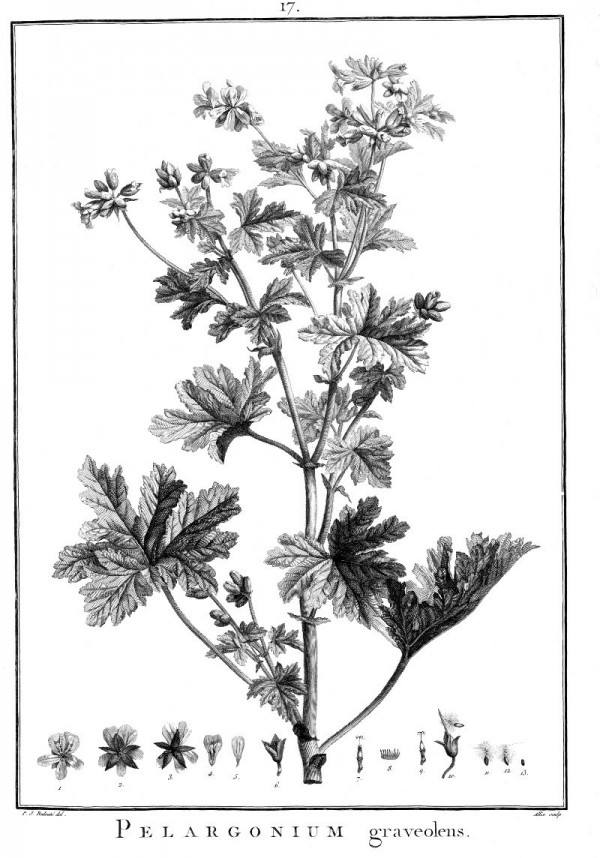
L’Héritier de Brutelle, C.L., Redouté, P.J., Geraniologia, t.17 (1787-1788)
http://plantgenera.org/species.php?id_species=760606
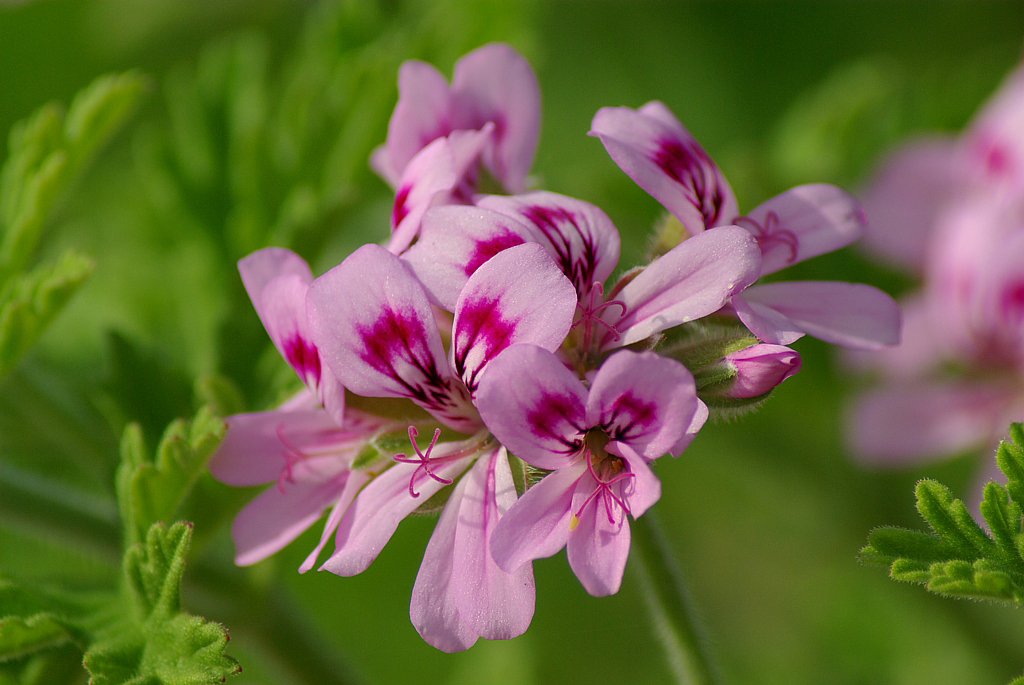
„Rose Geranium - cluster“ by Laitche, Wikimedia Commons, © Public Domain
VIDEO: Geranium from Egypt (IFF-LMR)

